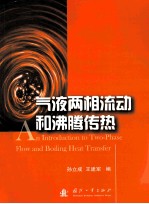图书介绍
气液两相流动和沸腾传热 英文【2025|PDF下载-Epub版本|mobi电子书|kindle百度云盘下载】

- 孙立成,王建军编 著
- 出版社: 北京:国防工业出版社
- ISBN:9787118094312
- 出版时间:2014
- 标注页数:168页
- 文件大小:19MB
- 文件页数:178页
- 主题词:两相流动-传热学-研究-英文
PDF下载
下载说明
气液两相流动和沸腾传热 英文PDF格式电子书版下载
下载的文件为RAR压缩包。需要使用解压软件进行解压得到PDF格式图书。建议使用BT下载工具Free Download Manager进行下载,简称FDM(免费,没有广告,支持多平台)。本站资源全部打包为BT种子。所以需要使用专业的BT下载软件进行下载。如BitComet qBittorrent uTorrent等BT下载工具。迅雷目前由于本站不是热门资源。不推荐使用!后期资源热门了。安装了迅雷也可以迅雷进行下载!
(文件页数 要大于 标注页数,上中下等多册电子书除外)
注意:本站所有压缩包均有解压码: 点击下载压缩包解压工具
图书目录
Chapter 1 Introduction1
1.1 What is Two-Phase Flow1
1.2 Methods of Analysis2
1.3 Notation3
Chapter 2 Flow Pattern and Flow Pattern Map6
2.1 Introduction6
2.2 Flow Patterns in Vertical Flows6
2.2.1 Flow patterns in vertical co-current flow6
2.2.2 Flow patterns in vertical heated channels8
2.3 Flow Patterns in Horizontal Flows10
2.3.1 Flow patterns in horizontal co-current flow10
2.3.2 Flow patterns in horizontal heated channel12
2.4 Flow Pattern Maps and Transitions12
2.4.1 Typical flow pattern maps13
2.4.2 Criteria for flow pattern transitions15
2.5 Flow Patterns in Other Applications17
Chapter 3 Basic Models18
3.1 Introduction18
3.2 Drift Flux Model19
3.3 Two-Fluid Model20
3.4 Homogeneous Model22
3.4.1 Conservation of mass23
3.4.2 Conservation of momentum24
3.4.3 Conservation of energy25
3.5 Separated Flow Model27
3.6 Overview27
Chapter 4 Empirical Methods for Pressure Drop28
4.1 Introduction28
4.2 Correlations Based on the Homogeneous Model28
4.3 Correlations Based on the Separated Flow Model31
4.3.1 Correlations from momentum balance31
4.3.2 Use of model to evaluate pressure loss33
4.3.3 Determination of the two-phase multiplier33
4.4 Pressure Losses Through Enlargements,Contractions,Orifices,Bends,and Valves40
4.4.1 Sudden enlargement41
4.4.2 Sudden contraction43
4.4.3 Orifices43
4.5 Annular Flow45
4.6 Void Fraction46
4.6.1 Homogeneous model47
4.6.2 Drift-flux model47
4.6.3 The Bankoff variable density model49
4.6.4 The Hughmark correlation50
4.7 Conclusions51
Chapter 5 Two-Phase Critical Flow52
5.1 Introduction52
5.2 Theoretical Foundations53
5.3 Critical Flow in Long Pipes55
5.4 Critical Flow in Short Pipes,Nozzles and Orifices59
5.5 Propagation of Pressure Pulses and Waves63
Chapter 6 Introduction to Hydrodynamic Instability64
6.1 Introduction64
6.2 Classifications of Two-Phase Flow Instabilities65
6.3 Physical Mechanisms of Static Instabilities67
6.3.1 Fundamental static instability67
6.3.2 Fundamental relaxation instability71
6.3.3 Compound relaxationinstability71
6.4 Physical Mechanisms of Dynamic Instabilities73
6.4.1 Fundamental dynamic instability73
6.4.2 Acoustic instability74
6.4.3 Density-wave oscillations75
6.4.4 Pressure-drop oscillations76
6.4.5 Condensing instability78
6.4.6 Thermal oscillations78
6.4.7 Boiling water reactor instability79
6.4.8 Parallel channel instability80
6.5 Approaches in Two-Phase Flow Stability Analysis80
6.5.1 Direct numerical analysis81
6.5.2 Frequency-domain analysis81
6.6 Situations Where Instability Arise82
6.7 The Designer's Requirements83
6.8 Problems Arising in the Application of Models and Tests to Designs84
Chapter 7 Introduction to Nucleation in Boiling86
7.1 Vapor-Liquid Equilibrium86
7.1.1 Equilibrium criterion86
7.1.2 P-v-T diagram86
7.1.3 Equation of state87
7.1.4 Metastable state88
7.1.5 Clausius-Clapeyron equation89
7.1.6 Thermodynamic equilibrium at a curved interface90
7.2 Homogeneous Nucleation92
7.2.1 Equilibrium condition for a embryo bubble93
7.2.2 Mechanism of nucleation94
7.3 Heterogeneous Nucleation95
7.3.1 Contact angle and wettability95
7.3.2 Nucleation at solid surfaces97
7.3.3 Nucleation from entrapped gas or vapor in cavities99
7.3.4 Size Range of Active Nucleation Sites101
7.4 Bubble Dynamics102
7.4.1 Bubble growth in an extensive liquid pool103
7.4.2 Bubble growth near heated surfaces107
7.4.3 Diameter and frequency of Bubble departure110
Chapter 8 Pool Boiling114
8.1 Nukiyama Boiling Curve114
8.2 Regimes of Pool Boiling116
8.3 Nucleate Boiling120
8.3.1 Inception of boiling(Onset of Nucleate Boiling)120
8.3.2 Heat transfer mechanisms in nucleate boiling123
8.3.3 Nucleate Pool Boiling Correlations125
8.4 Departure From Nucleate Pool Boiling128
8.4.1 Transitional boiling regime and Taylor instability128
8.4.2 Helmhohtz instability of vapor jets130
8.4.3 Prediction of critical heat flux131
8.5 Film Boiling133
8.6 Minimum Heat Flux134
Chapter 9 Flow Boiling135
9.1 Regimes of Convective Boiling in Tubes135
9.2 Onset of Boiling in Internal Flows140
9.3 Subcooled Flow Boiling143
9.3.1 Regimes of subcooled flow boiling143
9.3.2 Methods of predicting partial subcooled flow boiling heat transfer144
9.3.3 Void fraction and pressure drop in subcooled boiling147
9.4 Saturated Flow Boiling152
9.4.1 Regimes of saturated flow boiling152
9.4.2 Heat transfer correlations for saturated flow boiling153
9.5 Critical Heat Flux in Flow Boiling157
9.5.1 Mechanisms157
9.5.2 Prediction of CHF in flow boiling159
References167
热门推荐
- 3809876.html
- 2090248.html
- 2413052.html
- 2760561.html
- 1169280.html
- 3292351.html
- 2257652.html
- 2290768.html
- 477145.html
- 3470720.html
- http://www.ickdjs.cc/book_806451.html
- http://www.ickdjs.cc/book_3542584.html
- http://www.ickdjs.cc/book_3634917.html
- http://www.ickdjs.cc/book_744671.html
- http://www.ickdjs.cc/book_2675694.html
- http://www.ickdjs.cc/book_2186997.html
- http://www.ickdjs.cc/book_27645.html
- http://www.ickdjs.cc/book_1924495.html
- http://www.ickdjs.cc/book_1084978.html
- http://www.ickdjs.cc/book_2323382.html